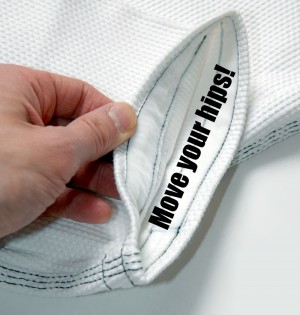Your Jiu-jitsu Cheat Sheet : Little Reminders to Improve Your Game
Back in high school, nervous exam taking students would scribble “cheat sheets” with the formula for calculating physics or math problems and hide them up their sleeves. When they got stuck, they would covertly sneak a peek at their notes and scribble down the correct answer.

Every new year of training, I set small, easily remembered training goals. Areas of my game that I need to improve, that I can reduce to a motto or short phrase and look to apply over a period of months. In joking to some of the students in my home Gracie Barra academy, I will tell them that I would write a message inside the sleeve of my kimono. When I got trapped in a tough spot, I would roll up my sleeve to see the message inside: “Move your hips!”.
In joking to some of the students in my home Gracie Barra academy, I will tell them that I would write a message inside the sleeve of my kimono. When I got trapped in a tough spot, I would roll up my sleeve to see the message inside: “Move your hips!”.
Reminded of the simple answer, I would roll the sleeve back up and, with renewed energy, commence serious hip escapes!
It was only a joke (at least the writing part!) but the training clue was helpful in a real, tangible way.
Sometimes to grow in our jiu-jitsu, we don’t need an additional technique. What we may need is to do the same techniques a little differently or to stop doing something unproductive.
For example:
Often during training at end of class, I will observe the students rolling and afterwards, take them aside and give them a simple, succinct piece of advice specific to what I identified in their roll.
One student, when attempting to escape from the bottom, would always grip his opponent tightly, with ineffective grips that not only served to anchor him to his opponent, but also exhausted his arms and filled them with lactic acid.
My advice / “cheat sheet” message to him was “On the bottom of side control, stop the ineffective grips!”. Every time he found himself on the bottom, to pause and remember that simple piece of advice that could help correct a bad habit.
Here are a few of the messages that you might find written inside my kimono sleeve 😉
1) “Move your hips!” – nearly every escape and major movement from the guard requires a hip escape to create the optimal angle. It is unfortunately not an instinctive movement for most of us and we must train it into our conditioned reflexes.
Concentrating on this simple principle each time I was on bottom moved my guard up to the next level. 2) “Break grips” – Observe most high level matches between black belt competitors and you will see a strategic battle for the dominant grip.
2) “Break grips” – Observe most high level matches between black belt competitors and you will see a strategic battle for the dominant grip.
I became aware that while attempting to pass the guard, my black belt opponents would secure their favorite grips and I was attempting to pass while they had the gripping advantage.
No more! I resolved that whenever I started to pass I would pause and deliberately break the opponent’s grips.
3) “Switch sides” – Everyone has a favorite side to play guard as well as pass. I observed that Rodolfo Viera – famous for his guard passing – would rapidly switch the sides that he was attempting to pass.
This forced the opponent to change their guard, and often their grips also. Each reset from left to right and right to left caused the opponent’s guard to lose a little of the control and Vieras would pass.
Now, when taking my pants grips and starting to pass, I would pause and remember my “cheat sheet tip”. Instead of picking my favorite side and repeatedly trying to pass in that direction, I would change direction at least once, before going with my best pass in the 2nd direction.
Reflecting on your own game development, you will have your own areas. Pick a single, simple thing to focus on for the next month.
Writing in the sleeve of your kimono is optional.
What Are Your Training Reminders?
Credits: Mark Mullen
GB Black belt from GB Calgary, Canada
Twitter: @MarkMullenBJJ
